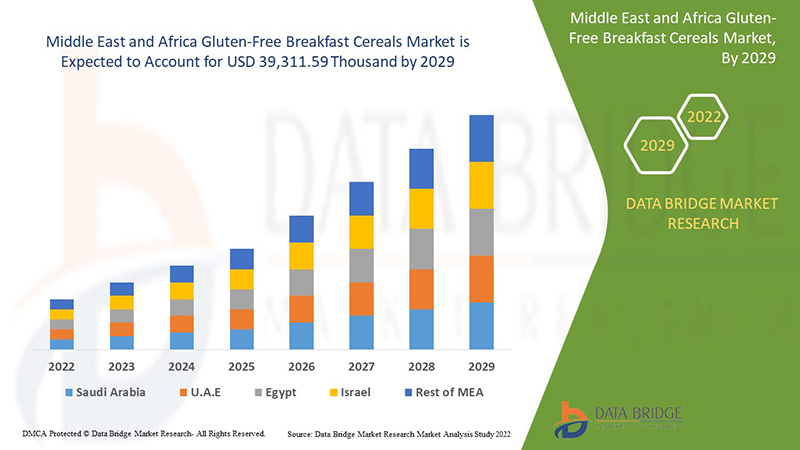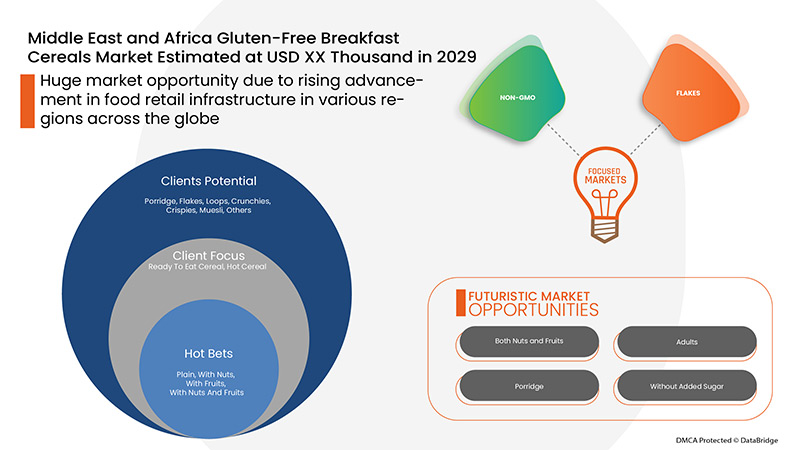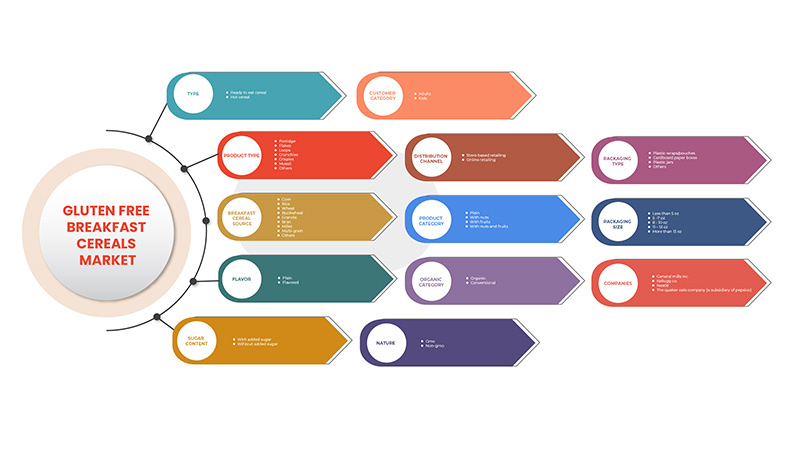
Market Analysis and Size
Gluten-free breakfast cereals are highly processed, with many ingredients added to reduce the risk of developing diseases such as coronary heart disease, cancer, diabetes, and diverticular disease. Breakfast cereals may be puffed, flaked, shredded, or coated in chocolate or frosting before it is dried, and finally, they are shaped into forms, such as balls, stars, loops, or rectangles.


The increasing demand for ready-to-cook breakfast cereals and increased health awareness among the consumers are expected to drive the demand for the Middle East & Africa gluten-free breakfast cereals market. Data Bridge Market Research analyses that the gluten-free breakfast cereals market is expected to reach the value of USD 39,311.59 thousand by the year 2029, at a CAGR of 6.1% during the forecast period. "Adults" accounts for the most prominent consumer category segment in the respective market owing to rise in the demand for gluten-free breakfast cereals due to increased awareness for healthy lifestyle. The market report curated by the Data Bridge Market Research team includes in-depth expert analysis, import/export analysis, pricing analysis, production consumption analysis, and climate chain scenario.
|
Report Metric |
Details |
|
Forecast Period |
2022 to 2029 |
|
Base Year |
2021 |
|
Historic Years |
2020 (Customizable to 2019 - 2014) |
|
Quantitative Units |
Revenue in USD Thousand, Pricing in USD |
|
Segments Covered |
By Type (Hot Cereal, Ready To Eat Cereal), Breakfast Cereal Product Type (Porridge, Flakes, Loops, Crunchies, Crispies, Muesli, Others) , Breakfast Cereal Source (Corn, Rice, Wheat, Buckwheat, Granola, Bran, Millet, Multi-Grains, Others), Flavor (Plain, Flavored), Sugar Content (With Added Sugar, Without Added Sugar), Product Category (Plain, With Nuts, With Fruits, Both Nuts And Fruits), Organic Category (Organic, Conventional), Nature (GMO, Non-GMO), Packaging Type (Plastic Wraps/Pouches, Cardboard Paper Boxes, Plastic Jars, Others), Packaging Size (Less Than 5 OZ, 5 - 7 OZ, 8 – 10 OZ, 11 – 13 OZ, More Than 13 OZ), Consumer Category (Adults, Kids), Distribution Channel (Store-Based Retailing, Online Retailing) |
|
Countries Covered |
Saudi Arabia, U.A.E, South Africa, Egypt, Israel, Rest of Middle East and Africa (MEA). |
|
Market Players Covered |
General Mills Inc. (Minnesota, U.S.), Kellogg's Company (Michigan, U.S.), Nestlé (Vevey, Switzerland), The Quaker Oats Company (a subsidiary of PepsiCo) (Illinois, U.S.), among others. |
Market Definition
Gluten-free breakfast cereal is made from processed grains and often fortified with vitamins and minerals, which is commonly eaten with milk, yogurt, fruit, or nuts. Gluten-free breakfast cereals are processed grains for human consumption and are usually packaged for sale as ready-to-eat (RTE) or hot cereals (HC) and must be cooked before consumption. The cereals are manufactured by continuous cooking, molding, and drying operations, after which flavors, sweeteners, vitamins, mineral fortifications, and particulate additive options are added before packaging. A cereal that has been derived from a gluten-containing grain can be labeled as “gluten-free” if it has been processed to remove gluten and consumption of that cereal results in the presence of less than 20 ppm of gluten in the food.
Regulatory Framework
Food and Drug Administration (FDA): The rule specifies, among other criteria, that any foods that carry the label “gluten-free,” “no gluten,” “free of gluten,” or “without gluten” must contain less than 20 parts per thousand (ppm) of gluten. This level is the lowest that can be reliably detected in foods using scientifically validated analytical methods. Other countries and international bodies use these same criteria, as most people with celiac disease can tolerate foods with very small amounts of gluten.
The Market Dynamics of the Gluten-Free Breakfast Cereals Market Include:
Drivers/Opportunities in the Gluten-Free Breakfast Cereals Market
- Increasing demand for ready-to-eat breakfast cereals
The ready-to-cook industry has served many consumers and responded to changing demands. The prepared meal made people's lives easier. The convenience provided by ready-to-eat foods provides a way to eat a healthy diet while adapting to the day's busy schedule. Also, ready-to-eat food such as granola and grains are delicious, healthy, and served as healthy meal option when eaten with milk and other healthy drinks.
- Shifting consumer preference toward gluten-free, organic, and whole grain-based cereals
Organic cereals are free from artificial flavors or preservatives, resulting in unadulterated food and diets, leading to a cleaner bill of health. Organic cereals are free from synthetic additives found in processed conventional foods. These chemically addictive additives lead to too many health problems, from diabetes to obesity and other food-related diseases, thus raising awareness for the organic food industry.
- Positive outlook towards convenience food products
The busy lifestyle of the millennial workforce, the increase in total family income, and the concept of nuclear family retention have all contributed to the significant growth of the convenience food products segment, including cereals, in recent years. The surge in demand for health foods has spawned an entire segment of packaged foods, including immune-boosting foods, healthy whole grains, and cereals.
- Increasing health awareness among consumers
People are more interested in healthy food such as cereals nowadays and visit those places that provide nutritious food and suit their health. They now understand that when they eat junk or without nutritious food and lower their diet quality, it has a high and dangerous impact on their health. Besides, consumers are also aware of their daily food quality and opt for nutritious food items such as cereals and wholesome grains.
Restraints/Challenges faced by the Gluten-Free Breakfast Cereals Market
- Availability of alternative breakfast options
The healthiest breakfast choices include a combination of protein, fiber, healthy fats, and a modest amount of unrefined carbohydrates to provide rapid energy. The alternatives to cereals include mini frittatas, muffins, bread, and many others, often filled with all sorts of vitamins and minerals and rich in vegetables. Therefore, the alternative breakfast items are overall much healthier for both the short and long run.
- Huge commercialization of counterfeit products
Counterfeit gluten complimentary breakfast cereal packages and products may look like real brands, but eating can cause many types of illness. Many consumers are unaware that their product is counterfeit, so if it does not function properly or does not meet overall expectations, the customer blames the authentic company. This may cause customers to lose confidence in the brand and not repurchase the same brand in the future.
COVID-19 had a Minimal Impact on Gluten-Free Breakfast Cereals Market
COVID-19 impacted various manufacturing and service providing industries in the year 2020-2021 as it led to the closure of workplaces, disruption of supply chains, and restrictions on transportation. Though, the imbalance between demand and supply and its impact on pricing is considered short-term and is expected to recover as this pandemic comes to an end. Due to outbreak of covid19 throughout the globe, the demand for gluten-free breakfast cereals was decreased. Thus, food industries suffered a lot during covid19 outbreak, the gluten-free breakfast cereals industry will hopefully grow with the removed restrictions in varied countries.
Recent Developments
- In May 2022, General Mills Inc. agreed to acquire TNT Crust, a manufacturer of high-quality frozen pizza crusts for regional and national pizza chains, foodservice distributors, and retail outlets. This acquisition will help the company expand its operations in the market.
- In 2020, Kellogg’s Co. was awarded America’s Most Trusted Brands (Morning Consult). This has enhanced company’s image in the Middle East & Africa market.
Middle East & Africa Gluten-Free Breakfast Cereals Market Scope
The gluten-free breakfast cereals market is segmented on the basis of type, breakfast cereal product type, breakfast cereal sources, flavor, sugar content, product category, organic category, nature, packaging size, packaging type, consumer category, distribution channel. The growth amongst these segments will help you analyze meagre growth segments in the industries and provide the users with a valuable market overview and market insights to help them make strategic decisions for identifying core market applications.
Type
- Ready To Eat Cereal
- Hot Cereal
On the basis of type, the gluten-free breakfast cereals market is segmented into hot cereal and ready to eat cereal.
Breakfast Cereal Product Type
- Porridge
- Flakes
- Loops
- Crunchies
- Crispies
- Muesli
- Others
On the basis of breakfast cereal product type, the gluten-free breakfast cereals market is segmented into porridge, flakes, loops, crunchies, crispies, muesli and others.
Breakfast Cereal Source
- Corn
- Wheat
- Bran
- Multi-Grain
- Millet
- Rice
- Buckwheat
- Granola
- Others
On the basis of breakfast cereal source, the gluten-free breakfast cereals market is segmented into corn, rice, wheat, buckwheat, granola, bran, millet, multi-grains, and others.
Flavor
- Plain
- Flavored
On the basis of flavor, the gluten-free breakfast cereals market is segmented into plain and flavored.
Sugar Content
- With Added Sugar
- Without Added Sugar
On the basis of sugar content, the gluten-free breakfast cereals market is segmented into with added sugar, without added sugar.
Product Category
- Plain
- With Nuts
- With Fruits
- Both Nuts and Fruits
On the basis of product category, the gluten-free breakfast cereals market is segmented into plain, with nuts, with fruits, both nuts and fruits.
Organic Category
- Organic
- Conventional
On the basis of organic category, the gluten-free breakfast cereals market is segmented into organic and conventional.
Nature
- GMO
- NON-GMO
On the basis of nature, the gluten-free breakfast cereals market is segmented into GMO and non-GMO.
Packaging Type
- Plastic Wraps/Pouches
- Cardboard Paper Boxes
- Plastic Jars
- Others
On the basis of packaging type, the gluten-free breakfast cereals market is segmented into plastic wraps/pouches, cardboard paper boxes, plastic jars and others.
Packaging Size
- Less Than 5 Oz
- 5 –7 Oz
- 8 - 10 Oz
- 11 – 13 Oz
- More Than 13 Oz
On the basis of packaging size, the gluten-free breakfast cereals market is segmented into less than 5 OZ, 5-7 OZ, 8-10 OZ, 11-13 OZ and more than 13 OZ.
Consumer Category
- Adults
- Kids
On the basis of consumer category, the gluten-free breakfast cereals market is segmented into adults and kids.
Distribution Channel
- Store-Based Retailing
- Online Retailing

On the basis of distribution channel, the gluten-free breakfast cereals market is segmented into store-based retailing and online retailing.
Gluten-Free Breakfast Cereals Market Regional Analysis/Insights
The gluten-free breakfast cereals market is analyzed and market size insights and trends are provided by country, type, breakfast cereal product type, breakfast cereal sources, flavor, sugar content, product category, organic category, nature, packaging size, packaging type, consumer category, distribution channel as referenced above.
The countries covered in the gluten-free breakfast cereals market report are the Saudi Arabia, U.A.E, South Africa, Egypt, Israel, Rest of Middle East and Africa (MEA).
South Africa dominates the gluten-free breakfast cereals market because of the new and improved product launches in the region. South Africa is followed by Saudi Arabia and is expected to witness significant growth during the forecast period of 2022 to 2029 due to growing demand for gluten-free breakfast cereals from adult consumer in the region. Saudi Arabia is followed by United Arab Emirates and is expected to grow significantly owing to positive outlook towards convenience food products.
The country section of the report also provides individual market impacting factors and changes in market regulation that impact the current and future trends of the market. Data points such as down-stream and upstream value chain analysis, technical trends and porter's five forces analysis, case studies are some of the pointers used to forecast the market scenario for individual countries. Also, the presence and availability of Middle East & Africa brands and their challenges faced due to large or scarce competition from local and domestic brands, impact of domestic tariffs and trade routes are considered while providing forecast analysis of the country data.
Competitive Landscape and Gluten-Free Breakfast Cereals Market Share Analysis
The gluten-free breakfast cereals market competitive landscape provides details by competitor. Details included are company overview, company financials, revenue generated, market potential, investment in research and development, new market initiatives, Middle East & Africa presence, production sites and facilities, production capacities, company strengths and weaknesses, product launch, product width and breadth, application dominance. The above data points provided are only related to the companies' focus related to gluten-free breakfast cereals market.
Some of the major market players engaged in the Middle East & Africa gluten-free breakfast cereals market are General Mills Inc., Kellogg's Company, Nestlé, The Quaker Oats Company (a subsidiary of PepsiCo), among others.
SKU-
Get online access to the report on the World's First Market Intelligence Cloud
- Interactive Data Analysis Dashboard
- Company Analysis Dashboard for high growth potential opportunities
- Research Analyst Access for customization & queries
- Competitor Analysis with Interactive dashboard
- Latest News, Updates & Trend analysis
- Harness the Power of Benchmark Analysis for Comprehensive Competitor Tracking
Middle East And Africa Gluten Free Breakfast Cereals Market, Supply Chain Analysis and Ecosystem Framework
To support market growth and help clients navigate the impact of geopolitical shifts, DBMR has integrated in-depth supply chain analysis into its Middle East And Africa Gluten Free Breakfast Cereals Market research reports. This addition empowers clients to respond effectively to global changes affecting their industries. The supply chain analysis section includes detailed insights such as Middle East And Africa Gluten Free Breakfast Cereals Market consumption and production by country, price trend analysis, the impact of tariffs and geopolitical developments, and import and export trends by country and HSN code. It also highlights major suppliers with data on production capacity and company profiles, as well as key importers and exporters. In addition to research, DBMR offers specialized supply chain consulting services backed by over a decade of experience, providing solutions like supplier discovery, supplier risk assessment, price trend analysis, impact evaluation of inflation and trade route changes, and comprehensive market trend analysis.
Research Methodology
Data collection and base year analysis are done using data collection modules with large sample sizes. The stage includes obtaining market information or related data through various sources and strategies. It includes examining and planning all the data acquired from the past in advance. It likewise envelops the examination of information inconsistencies seen across different information sources. The market data is analysed and estimated using market statistical and coherent models. Also, market share analysis and key trend analysis are the major success factors in the market report. To know more, please request an analyst call or drop down your inquiry.
The key research methodology used by DBMR research team is data triangulation which involves data mining, analysis of the impact of data variables on the market and primary (industry expert) validation. Data models include Vendor Positioning Grid, Market Time Line Analysis, Market Overview and Guide, Company Positioning Grid, Patent Analysis, Pricing Analysis, Company Market Share Analysis, Standards of Measurement, Global versus Regional and Vendor Share Analysis. To know more about the research methodology, drop in an inquiry to speak to our industry experts.
Customization Available
Data Bridge Market Research is a leader in advanced formative research. We take pride in servicing our existing and new customers with data and analysis that match and suits their goal. The report can be customized to include price trend analysis of target brands understanding the market for additional countries (ask for the list of countries), clinical trial results data, literature review, refurbished market and product base analysis. Market analysis of target competitors can be analyzed from technology-based analysis to market portfolio strategies. We can add as many competitors that you require data about in the format and data style you are looking for. Our team of analysts can also provide you data in crude raw excel files pivot tables (Fact book) or can assist you in creating presentations from the data sets available in the report.













